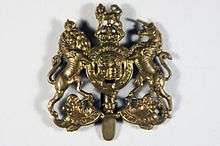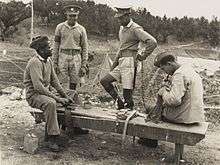General Service Corps
The General Service Corps (GSC) is a corps of the British Army.
| General Service Corps | |
|---|---|
 Cap Badge of the General Service Corps | |
| Active | 1914– |
| Allegiance | |
| Branch | |
| Role | For specialists, not allocated to a regiment or corps |
| Beret | Dark blue |
Role
The role of the corps is to provide specialists, who are usually on the Special List or General List.[1]
History
The corps was founded in 1914 at the outbreak of World War I for specialists and those not allocated to other regiments or corps.[2] It was used for similar purposes in World War II, including for male operatives of the Special Operations Executive (female operatives joined the FANY).[3][4]
From July 1942, army recruits were enlisted in the corps for their first six weeks so that their subsequent posting could take account of their skills and the Army's needs.[5] A similar role, holding some recruits pending allocation to their units, continues today.[6][7][8][9] Bermuda Militia Infantry soldiers absorbed into the Bermuda Militia Artillery before demobilisation in 1946 wore the General Service Corps cap badge instead of the Royal Artillery cap badge.[10]
Insignia

From 1914, the cap badge has been the Royal Arms, with variously a king's or a queen's crown, depending on the reigning monarch. It bears the motto of the monarch Dieu et mon droit and the Order of the Garter motto Honi soit qui mal y pense.[11] As a result, a GSC nickname was 'Crosse and Blackwell' after the firm whose tins and jar labels had a prominent royal coat of arms.[12]
Notable personnel
Notable members of the General Service Corps include:
- Walter Freud[13]
- Peter Lake[14][15]
- T. E. Lawrence (Lawrence of Arabia)[16]
- Bob Maloubier[17]
- John Pendlebury[18]
- Tracy Philipps[19]
- Arthur Staggs[20]
Order of Precedence
The corps is twenty-second in the British Army's order of precedence.[21]
| Preceded by Royal Army Physical Training Corps |
Order of Precedence | Succeeded by Queen Alexandra's Royal Army Nursing Corps |
References
- "Combat Service Support". armedforces.co.uk. Retrieved 10 May 2014.
- Imperial War Museum. "Badge, Headdress, British, General Service Corps". Retrieved 8 November 2017.
- Foot, M R D (2006). SOE in France: An Account of the Work of the British Special Operations Executive in France 1940–1944. Routledge.
- Tillotson, M (2001). SOE and the Resistance as Told in the Times Obituaries. London: Continuum. p. xii.
- William H. Beveridge (2014) [1943]. The Pillars of Security (Works of William H. Beveridge). Taylor & Francis. ISBN 978-1-317-57304-3.
- Vila, Maurice. "WW2 People's War". BBC. Retrieved 9 November 2017.
- Pigott, A J K (1960). Manpower Problems: The Second World War 1939–1945. London: The War Office.
- Crang, J A (2000). The British Army and the People's War 1939–1945. Manchester University Press. p. 14. ISBN 978-0719047411.
- Heyman, C (2012). The British Army Guide 2012–2013. Pen and Sword Military. p. 144.
- The Bermuda Regiment website: Brief History of the Bermuda Regiment
- Imperial War Museum. "Badge, Headdress, British, General Service Corps". Retrieved 8 November 2017.
- Waugh, Evelyn (1977). Put Out More Flags. Little, Brown and Company. ISBN 978-0316926157.
- van den Vat, Dan (2004-03-09). "Walter Freud Obituary". THe Guardian. Retrieved 9 November 2017.
- Lake, Peter (2009-07-12). "Daily Telegraph Obituary". Daily Telegraph. Retrieved 9 November 2017.
- Perrin, Nigel. "Peter Lake". Retrieved 9 November 2017.
- "Major Thomas Edward LAWRENCE". The National Archives. The National Archives. Retrieved 8 November 2017.
- Davidson, Phil (2015-04-27). "Bob Maloubier Obituary". The Independent. Retrieved 9 November 2017.
- Grundon, Imogen (2007). The Rash Adventurer: A Life of John Pendlebury. Libri. ISBN 978-1901965063.
- "Supplement to the London Gazette, 6 February, 1922" (PDF). The London Gazette. p. 1062. Retrieved 17 August 2019.
- Staggs, Arthur (2013-10-20). "Arthur Staggs Obituary". The Daily Telegraph. Retrieved 9 November 2017.
- The Queen's Regulations for the Army, Chapter 8, Ceremonial (PDF). Retrieved 9 November 2017.